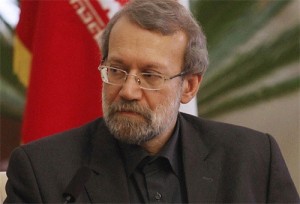 Belgrade, Oct 7, IRNA The Iranian Parliament Speaker Ali Larijani visited Serbias Saint Sava Cathedral and a History Museum in the city allocated to the history of former Yugoslavia on the first day of his two-day tour of Serbia.
Belgrade, Oct 7, IRNA The Iranian Parliament Speaker Ali Larijani visited Serbias Saint Sava Cathedral and a History Museum in the city allocated to the history of former Yugoslavia on the first day of his two-day tour of Serbia.A Serbian historian, fine arts master and tourist guide, Liobomir Panich, accompanied Larijani and the Iranian delegation throughout the tour and presented explanations on Saint Sava Cathedral which is the largest church throughout Serbia and even the Balkans region, and one of the largest in the world. He said, This cathedral is about a century old.
He meanwhile explained that during its 100 year history the cathedral has been faced with lots of dramatic events, including World War I and World War II, as well as the infamous Balkans War.
Panich added that the idea of constructing the Saint Sava Cathedral, which is both historically and religiously of great significance for the Serbian nation, dates back to the 19th century.
The Cathedral of Saint Sava or Temple of Saint Sava is a Serbian Orthodox church located in Vracar, Belgrade, Serbia.
It is the largest Orthodox church in the world and ranks amongst the ten largest church buildings in the world. The church is dedicated to Saint Sava, the founder of the Serbian Orthodox Church and an important figure in medieval Serbia. It is built on the Vracar plateau, on the location where it is alleged that his remains were burned in 1595 by the Ottoman Empires Sinan Pasha.
From its location, it dominates Belgrades cityscape, and is perhaps the most monumental building in the city. The building of the church structure is being financed exclusively by donations. The parish home is nearby, as will be the planned patriarchal building.
The Iranian parliament speaker and his accompanying delegation after visiting the Cathedral of Saint Sava also visited a History Museum in Belgrade that is allocated to the history of the former Yugoslavia.
The presents of kings, queens and presidents to the former leader of Yugoslavia, Marshal Josip Broz Tito, are kept at this museum.
Among them there are also four gifts from the Iranian monarchs, including a model of the internationally renowned charter of human rights of the Achaemind King, Cyrus the Great, a gold box, a gold necklace, and fine inlaid frame.
Larijani and the Iranian delegation also visited Titos tomb, which is also known as the flower house and is located right behind the museum, and paid respect to him.
Earlienr in the day, the visiting Iranian parliament speaker had visited this citys Bajrakli Mosque, Serbias largest one, and met and conferred with its congregational prayers Imam Mustafa Yusuf Sipahich.
Sipahich is meanwhile the Grand Mufti of Novi Vojvodina, a province in the north of Serbia, briefed Larijani and his accompanying delegation on the old history of the Bajrakli Mosque, the Muslim population of Serbia, and the activities of the mosque and the Halal food shops in that country.
Larijani for his part said in the meeting that the Bajrakli Mosque officials can visit Iran and get better acquainted with the ancient country.
The Iranian parliament speaker and his accompanying delegation who were accompanied with the ambassador of the Islamic Republic of Iran in Belgrade after the meeting performed their evening and night time prayers at Bajrakli Mosque.
Larijani arrived in Belgrade at the top of a high ranking delegation and was received by his Serbian counterpart, the Iranian ambassador, and the staff members of the Iranian Embassy in Belgrade.
Larijani is scheduled to meet the Serbian President Tomislav Nikolic, Parliament Speaker Nebojsa Stefanovic, Prime Minister Ivica Dacic.
The Iranian and Serbian officials discussed bilateral ties, particularly in economic and cultural fields, as well as regional and international developments.
The Bajrakli Mosque named in Turkish as Bayrakli, (bayrak is the Turkish word for flag and Bayrakli means with flag) is a mosque in Belgrade, the capital of Serbia.
It is located in Gospodar Jevremova Street in the neighborhood of Dorcol. It was built around 1575 and is the only mosque in the city out of 273 mosques that had existed during the time of the Ottoman Empires rule of Serbia.
Iranian Parliament Speaker Ali Larijani arrived in Serbias capital city, Belgrade, Sunday morning at the head of a parliamentary delegation for talks with his counterpart and other high ranking Serbian officials.
Larijanis visit of Serbia is the first leg of his tour of three European countries, which also takes him to Geneva, Switzerland, where he is to attend the Inter-Parliamentary Union session.
Larijani is scheduled to give an address at the IPU meeting, in the presence of 30 parliament speakers and 20 vice speakers, and to have bilateral meetings with the parliamentarians of some member countries on regional and international developments during his two-day trip to Geneva.
On Wednesday, October 9 and after the end of the IPU meeting, Larijani heads for Croatia, where he will have meetings on various regional and international developments with that countrys parliamentarian and political officials.
The Inter-Parliamentary Union (IPU) is the international organization of world parliaments and was established in 1889.
The union is the focal point for world-wide parliamentary dialogue and works for peace and cooperation among peoples aimed at firm establishment of democracy around the globe.
The IPU is financed primarily by its members out of public funds. The site of the Unions Headquarters is Geneva (Switzerland).
By IRNA
The Iran Project is not responsible for the content of quoted articles.










